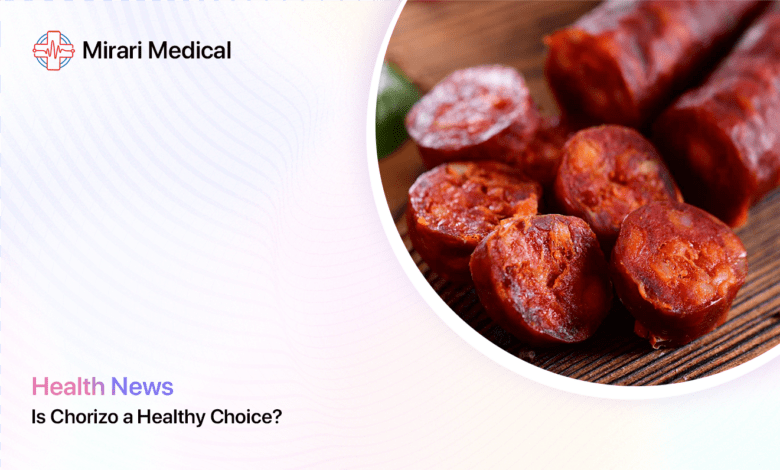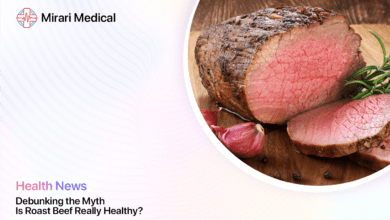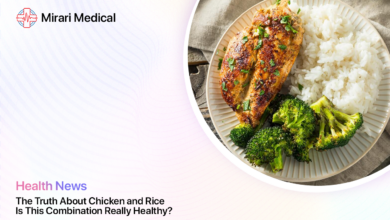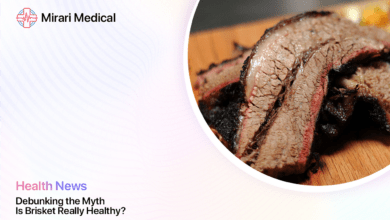Is Chorizo a Healthy Choice?

You may be interested
Did you know that chorizo, a popular spicy pork sausage, has been enjoyed for centuries in countries like Spain, Mexico, and Portugal? This flavorful meat has recently gained popularity in the United States as well, popping up on restaurant menus and in home kitchens. But with its rich taste and red color, many people wonder: is chorizo actually a healthy choice? In this article, we’ll explore the different types of chorizo, dive into its nutritional value, and weigh the potential health benefits and risks. By the end, you’ll have a better understanding of how this tasty sausage can fit into a balanced diet.
What Is Chorizo?
At its most basic, chorizo is a type of pork sausage that is heavily seasoned with spices like paprika, garlic, and chili peppers. However, there are many different varieties of chorizo depending on the country and region of origin.
Chorizo is believed to have originated in Catalonia, a region in northeastern Spain, sometime in the late 15th century.[1] From there, it spread to other parts of Spain and eventually to the Spanish colonies in Latin America. As the sausage traveled and evolved, distinct styles emerged based on local ingredients, traditions, and tastes.
Today, chorizo is an integral part of the cuisine in Spain, Mexico, Portugal, Puerto Rico, and many other Latin American countries. It’s used in a wide variety of dishes, from tacos and burritos to paellas and stews. Chorizo is prized for its bold, spicy flavor and versatility in cooking.
So what exactly goes into this popular sausage? The main ingredient in all types of chorizo is pork, usually from the shoulder or belly of the pig. The meat is chopped or ground and then mixed with a blend of spices that typically includes paprika, garlic, salt, and various chili peppers. Some recipes also include red wine, vinegar, or herbs like oregano.
The specific ingredients and proportions vary widely depending on the region and the individual recipe. For example, Spanish chorizo often contains smoked paprika (pimentón) which gives it a deep red color and smoky flavor. Mexican chorizo, on the other hand, is usually seasoned with vinegar and fresh chilis like jalapeños or serranos for a brighter, tangier taste.
After the meat is seasoned, it’s stuffed into natural or artificial casings and then cured, smoked, or cooked depending on the variety. The finished sausage can be sold as fresh chorizo that needs to be cooked before eating, or as a dry-cured or semi-cured sausage that can be sliced and eaten without further cooking.
One interesting thing about chorizo is that it has inspired some creative meat-free and vegan versions designed to mimic the texture and flavor of the traditional sausage. Soyrizo, for example, is a vegan chorizo made from soy protein, spices, and oil that has become popular among vegans and vegetarians. While not exactly the same as pork-based chorizo, these plant-based alternatives can be a tasty option for those avoiding meat.
What Are the Different Types of Chorizo?
While all chorizo is a spicy, seasoned pork sausage, there are several distinct varieties that differ in ingredients, preparation, and flavor profile. Understanding the different types of chorizo is important for knowing how to use them in cooking and what to expect in terms of taste and texture. Here’s a breakdown of the three main categories of chorizo:
1. Spanish Chorizo
Spanish chorizo is probably the most well-known type of chorizo worldwide. It’s a cured sausage that comes in two main varieties: fully-cured chorizo that is dry and firm in texture, and semi-cured chorizo that is softer and needs to be cooked before eating.
The key ingredient that sets Spanish chorizo apart is smoked paprika (pimentón). This spice gives the sausage its characteristic deep red color and smoky flavor. Spanish chorizo also typically contains garlic, oregano, and white wine.
There are many regional varieties of Spanish chorizo, each with its own unique blend of spices and preparation methods. Some famous types include:
- Chorizo Riojano: A spicy, dry-cured chorizo from the La Rioja region flavored with garlic and pimentón
- Chorizo Ibérico: Made from black Iberian pigs that are fed a diet of acorns, this premium chorizo has a rich, nutty flavor
- Chorizo de Pamplona: A semi-cured sausage from Navarre that is stuffed into wider casings and has a milder flavor
Spanish chorizo can be eaten on its own as a tapa (appetizer), or used in dishes like paella, stews, and soups. The dry-cured versions are often served thinly sliced alongside cheese and olives, while the semi-cured types are better for cooking into dishes.
2. Mexican Chorizo
Unlike Spanish chorizo, Mexican chorizo is a fresh sausage that is sold raw and must be cooked before eating. It also has a very different flavor profile, with a spicier, more vinegary taste compared to the smoky, garlicky Spanish varieties.
Mexican chorizo is typically seasoned with a blend of dried chilis like guajillo and ancho, along with vinegar, garlic, oregano, and other spices. The meat is usually ground more finely than Spanish chorizo, giving it a softer, crumblier texture when cooked.
One of the most popular ways to enjoy Mexican chorizo is in chorizo con huevos, a breakfast dish of scrambled eggs cooked with crumbled chorizo. The sausage is also a common filling for tacos, burritos, quesadillas, and other Mexican favorites.
Some regional styles of Mexican chorizo include:
- Chorizo Verde: A green chorizo made with fresh herbs and chilis like tomatillos and jalapeños
- Chorizo Norteño: A spicy, fatty chorizo from northern Mexico often served in tacos
- Longaniza: A long, thin sausage seasoned with cinnamon and cloves that is popular in central Mexico
When cooking with Mexican chorizo, it’s important to remove the casing and fry the crumbled meat in a pan until it’s browned and crispy. The rendered fat adds a ton of flavor to whatever dish you’re preparing.
3. Portuguese Chorizo
While perhaps less well-known than its Spanish and Mexican counterparts, Portuguese chouriço (or chorizo) is an important part of the country’s cuisine. Like Spanish chorizo, the Portuguese version is a smoked and cured sausage made from pork and seasoned with garlic and paprika.
However, Portuguese chouriço tends to be spicier and fattier than Spanish chorizo. It also often includes other ingredients like red wine, bay leaves, and sometimes even cinnamon or cumin for a unique flavor profile.
There are many regional varieties of Portuguese chouriço, but some of the most famous include:
- Chouriço de Vinho: A sausage made with red wine that has a slightly tangy, fruity flavor
- Farinheira: A smoked sausage made with wheat flour and spices, but no meat
- Alheira: A sausage made with a mix of meats (usually pork and poultry) and bread that was historically created by Portuguese Jews as a way to avoid detection during the Inquisition
Portuguese chouriço is often used in hearty stews and soups, or grilled and served on its own as a snack or appetizer. It’s also a key ingredient in the famous Portuguese dish caldo verde, a soup made with potatoes, collard greens, and sliced chouriço.
While Spanish, Mexican, and Portuguese chorizos are the most common types, there are many other varieties enjoyed around the world. For example, Filipino, Puerto Rican, and Panamanian cuisine all have their own unique styles of chorizo that reflect local ingredients and flavors.
The key thing to remember is that not all chorizos are interchangeable in recipes. A dry-cured Spanish chorizo and a fresh Mexican chorizo will behave very differently when cooked and will impart distinct flavors to a dish. So when trying out a new chorizo recipe, be sure to use the specific type of sausage the recipe calls for to get the best results.
Is Chorizo a Healthy Choice?
Now that we’ve covered the different types of chorizo, let’s dive into the main question at hand: is this spicy pork sausage a healthy choice? As with many foods, the answer isn’t a simple yes or no. It depends on various factors like the specific nutritional value of the chorizo, how it’s prepared, and how often it’s consumed.
1. Nutritional Value of Chorizo
To understand the potential health benefits and drawbacks of chorizo, we first need to look at its nutritional profile. While the exact numbers can vary based on the specific brand and recipe, here are the average nutrients in a 1-ounce (28-gram) serving of Spanish-style chorizo:[2]
- Calories: 126
- Protein: 6 grams
- Fat: 11 grams
- Saturated fat: 4 grams
- Carbohydrates: 0 grams
- Fiber: 0 grams
- Sodium: 293 milligrams
As you can see, chorizo is a high-fat, high-protein food. Most of the calories come from fat, with a significant portion being saturated fat. Chorizo also tends to be high in sodium, with a single ounce providing over 10% of the daily recommended limit.
On the positive side, chorizo does offer some important micronutrients. It’s a good source of:
- Vitamin B12: 19% of the Daily Value (DV)
- Zinc: 7% of the DV
- Selenium: 6% of the DV
- Iron: 4% of the DV
- Potassium: 3% of the DV
Vitamin B12 is important for red blood cell formation, neurological function, and DNA synthesis, while minerals like zinc, selenium, and iron support immune health, thyroid function, and oxygen transport throughout the body.
However, it’s important to note that you can get these nutrients from many other foods, often in a more balanced package. Lean meats like chicken and fish, for example, provide protein and B12 with much less saturated fat and sodium.
2. Health Benefits of Chorizo
Despite its nutritional drawbacks, some research suggests that chorizo may offer certain health benefits when consumed in moderation. One potential perk is related to its high concentration of oleic acid.
Oleic acid is a type of monounsaturated fat found in olive oil, avocados, and certain meats like pork. Some studies have found that diets high in oleic acid may help improve cholesterol levels and reduce inflammation in the body.[3]
For example, a 2012 study published in the journal Lipids in Health and Disease compared the effects of eating a Spanish-style chorizo rich in oleic acid versus a chorizo made with palm oil. After four weeks, the group eating the high-oleic acid chorizo had significantly lower levels of LDL (“bad”) cholesterol and higher levels of HDL (“good”) cholesterol compared to the palm oil group.[4]
Another possible benefit of chorizo is its high protein content. Protein is important for building and repairing tissues, making enzymes and hormones, and supporting immune function. It also helps keep you feeling full and satisfied after meals.
A 3-ounce serving of chorizo provides about 18 grams of protein, which is 36% of the daily recommended intake for a sedentary adult woman. Protein needs are even higher for men, active individuals, and older adults.
Of course, chorizo isn’t the only or best way to get more protein in your diet. Leaner options like skinless chicken, fish, beans, and tofu can give you a protein boost without the high levels of saturated fat and sodium in chorizo.
3. Risks and Side Effects of Chorizo
On the flip side, regularly eating large amounts of processed meats like chorizo has been linked to some serious health risks. According to the World Health Organization, consuming 50 grams of processed meat per day (about 2 ounces) is associated with an 18% increased risk of colorectal cancer.[5]
Processed meats are those that have been transformed through salting, curing, fermentation, smoking, or other processes to enhance flavor or improve preservation. This includes sausages like chorizo, hot dogs, bacon, and deli meats.
The high saturated fat and sodium content in chorizo may also contribute to heart disease risk factors like high blood pressure and high cholesterol in some people. Saturated fat can raise levels of LDL cholesterol, while excess sodium intake can increase blood pressure, both of which strain the cardiovascular system over time.
Additionally, some people may be sensitive to certain compounds naturally present in pork products like chorizo. For example, pork is high in purines, which can raise levels of uric acid in the body and trigger gout flare-ups in susceptible individuals.
Pork is also a common food allergen, with reactions ranging from mild itching to severe anaphylaxis. If you have a known pork allergy or experience symptoms like hives, stomach pain, or difficulty breathing after eating chorizo, it’s best to avoid the sausage altogether.
As with any food, individual tolerance to chorizo can vary. Some people may be able to enjoy it regularly without any noticeable side effects, while others may feel better limiting their intake. If you have any pre-existing health conditions or concerns, it’s always a good idea to talk to your doctor or a registered dietitian about the best way to incorporate chorizo into your diet.
How to Incorporate Chorizo into a Healthy Diet?
If you enjoy the bold flavor of chorizo and want to include it in your healthy eating plan, there are several strategies you can use to maximize the benefits and minimize the potential downsides. Here are some tips for incorporating chorizo into a balanced diet:
1. Balance Portion Sizes
The first key to enjoying chorizo in a healthy way is to watch your portion sizes. While it may be tempting to load up on this tasty sausage, remember that a little goes a long way in terms of flavor and nutrition.
A good rule of thumb is to stick to a 1-2 ounce serving of chorizo, or about the size of a deck of cards. This provides enough of the sausage to add flavor and protein to a dish without going overboard on calories, fat, and sodium.
For example, instead of making chorizo the star of your meal, try using it as a flavor accent in dishes like soups, stews, or scrambled eggs. A small amount of crumbled chorizo can add a ton of savory depth to a pot of beans or a vegetable frittata without dominating the dish.
2. Choose Leaner Varieties
Another way to make chorizo a healthier choice is to opt for leaner varieties when possible. While all chorizo is relatively high in fat, some types are lower in calories and saturated fat than others.
For example, chorizo made from leaner cuts of pork like the loin or tenderloin will generally be lower in fat than those made from fattier cuts like the belly or shoulder. Some brands also offer reduced-fat or turkey chorizo options that can be a good choice for those watching their calorie intake.
When shopping for chorizo, take a look at the nutrition label and ingredient list. Choose varieties that have less than 5 grams of saturated fat and 500 milligrams of sodium per serving. Also, look for chorizo made with simple, whole-food ingredients like pork, spices, and vinegar rather than those with long lists of preservatives and additives.
3. Pair with Nutrient-Dense Foods
One of the best ways to enjoy chorizo as part of a healthy diet is to pair it with plenty of nutrient-dense whole foods like vegetables, whole grains, and legumes. These foods provide fiber, vitamins, minerals, and antioxidants that can help balance out the less-healthy aspects of the sausage.
For example, try adding a small amount of crumbled chorizo to a big leafy green salad, a veggie-packed frittata, or a pot of bean soup. The bold flavor of the chorizo can make these nutritious dishes feel more satisfying and indulgent without adding a lot of extra calories or fat.
You can also use chorizo as a topping for foods like baked potatoes, roasted vegetables, or whole-grain bowls. Just be sure to watch your portion sizes and balance the chorizo with plenty of colorful produce and fiber-rich starches.
4. Use as a Flavor Enhancer
Finally, remember that chorizo is a flavor powerhouse that can add a lot of depth and complexity to dishes in small amounts. Rather than making it the main event, try using chorizo as a flavor enhancer in your favorite recipes.
For example, you can add a small amount of finely chopped chorizo to homemade tomato sauce, chili, or stew for a smoky, spicy kick. Or, use a few thin slices of Spanish-style chorizo to top a pizza or garnish a salad.
By using chorizo as a condiment or accent rather than the main protein source, you can enjoy its delicious flavor without going overboard on the less-healthy nutrients. This approach also helps stretch a small amount of chorizo further, making it a more budget-friendly choice.
Can Chorizo Be Part of a Weight Loss Diet?
If you’re trying to lose weight, you may be wondering if chorizo can fit into your diet plan. While this spicy pork sausage is relatively high in calories and fat, it can still be enjoyed in moderation as part of a balanced approach to weight loss.
1. High Protein Content
One potential benefit of including chorizo in a weight loss diet is its high protein content. Protein is important for preserving lean muscle mass, which helps keep your metabolism revved up and burning calories efficiently.
Protein also tends to be more satiating than carbs or fat, meaning it can help keep you feeling full and satisfied between meals. This can be especially helpful when trying to cut calories and control portion sizes.
A 3-ounce serving of chorizo provides about 18 grams of protein, which is a significant chunk of the daily recommended intake. Pairing chorizo with other high-protein foods like eggs, beans, or low-fat dairy can help you meet your protein needs while staying within your calorie budget.
2. Moderate Fat Content
While chorizo is relatively high in total fat and saturated fat, it’s important to remember that fat is not the enemy when it comes to weight loss. In fact, including moderate amounts of healthy fats in your diet can actually help you feel more satisfied and less likely to overeat.
The key is to choose mostly unsaturated fats like those found in olive oil, nuts, seeds, and avocados, and to limit saturated fats like those in chorizo and other processed meats. Aim to keep your total fat intake to about 20-35% of your daily calories, with saturated fat making up no more than 10%.
When enjoying chorizo as part of a weight loss diet, be sure to watch your portion sizes and balance it with plenty of low-fat, high-fiber foods like vegetables, fruits, and whole grains. These foods can help fill you up without adding a lot of extra calories.
3. Watch for Added Sugars and Sodium
One potential pitfall of including chorizo in a weight loss diet is its high sodium content. Excess sodium intake can cause water retention and bloating, which can make you feel heavier and less comfortable in your clothes.
Some types of chorizo, especially Mexican-style varieties, may also contain added sugars in the form of sweeteners like dextrose or corn syrup. These added sugars can contribute empty calories and cause blood sugar spikes and crashes that may trigger cravings and overeating.
To minimize these risks, look for chorizo brands that are lower in sodium and free from added sugars. You can also balance out the sodium in chorizo by pairing it with potassium-rich foods like bananas, potatoes, and leafy greens, which can help flush excess water from your body.
Conclusion: Is Chorizo a Healthy Choice?
So, is chorizo a healthy choice? As with many foods, the answer is: it depends. While this spicy, flavorful sausage does offer some nutritional benefits like protein and micronutrients, it also comes with some potential downsides like high levels of saturated fat, sodium, and preservatives.
Ultimately, whether chorizo is a healthy choice for you will depend on your individual needs, preferences, and overall dietary pattern. If you enjoy the taste of chorizo and can fit it into your calorie and nutrient budget, there’s no need to avoid it completely.
However, it’s important to remember that chorizo is best enjoyed in moderation as an occasional treat rather than an everyday staple. Choosing leaner varieties, watching your portion sizes, and pairing chorizo with plenty of nutrient-dense whole foods can help you reap the flavor benefits while minimizing the potential health risks.
If you have any pre-existing health conditions like heart disease, high blood pressure, or gout, or if you are trying to lose weight, it’s a good idea to talk to your doctor or a registered dietitian before adding chorizo to your regular diet. They can help you determine if this spicy sausage is a good fit for your individual needs and goals.
At the end of the day, the healthiest diet is one that includes a wide variety of whole, minimally processed foods from all the major food groups. By focusing on balance, moderation, and enjoyment, you can find a way to savor flavorful foods like chorizo while still supporting your overall health and well-being.
FAQs
Is chorizo good for a diet?
Chorizo can be incorporated into a healthy diet in moderation, but it is relatively high in calories, fat, and sodium. Choosing leaner varieties, watching portion sizes, and balancing chorizo with nutrient-dense foods like vegetables and whole grains can make it a better fit for a weight loss or healthy eating plan.
What are the benefits of eating chorizo?
Some potential benefits of eating chorizo include its high protein content, which can help support muscle growth and repair, and its rich flavor, which can add depth and satisfaction to meals. Chorizo also contains some important micronutrients like vitamin B12, zinc, and selenium.
Is chorizo a highly processed food?
Yes, chorizo is considered a processed meat, meaning it has been modified from its original form through salting, curing, smoking, or other preservation methods. Processed meats have been linked to an increased risk of certain health problems like colorectal cancer and heart disease when consumed regularly.
Is chorizo healthy in moderation?
Enjoying chorizo in moderation as part of a balanced diet is unlikely to cause harm for most healthy people. However, those with certain health conditions like heart disease, high blood pressure, or gout may need to limit their intake of processed meats like chorizo.
Is chorizo a junk food?
While chorizo is not the most nutritious choice, it is not necessarily a “junk food” if enjoyed in moderation. Junk foods are typically defined as those that are high in calories, fat, sugar, and salt but low in essential nutrients like vitamins, minerals, and fiber. Chorizo does offer some beneficial nutrients like protein and micronutrients, but it is still best consumed as an occasional treat rather than a daily staple.
Can I eat chorizo everyday?
Eating chorizo every day is not recommended, as it is a processed meat that is high in saturated fat, sodium, and potentially harmful additives. Consuming processed meats regularly has been linked to an increased risk of certain health problems like colorectal cancer and heart disease. It’s best to enjoy chorizo in moderation as part of a varied diet that emphasizes whole, minimally processed foods.
Takeaways
- Chorizo is a type of spicy pork sausage that originated in Spain but is now enjoyed in many countries around the world, including Mexico and Portugal.
- There are several different types of chorizo, including Spanish-style chorizo, which is cured and smoked, and Mexican-style chorizo, which is fresh and uncooked. Each variety has its own unique blend of spices and preparation methods.
- Chorizo is relatively high in calories, fat, and sodium, but it also offers some beneficial nutrients like protein, vitamin B12, and minerals like zinc and selenium.
- Regularly consuming processed meats like chorizo has been linked to an increased risk of certain health problems like colorectal cancer and heart disease. However, enjoying chorizo in moderation as part of a balanced diet is unlikely to cause harm for most healthy people.
- To make chorizo a healthier choice, look for leaner varieties, watch your portion sizes, and pair it with plenty of nutrient-dense foods like vegetables, whole grains, and legumes.
- If you have any pre-existing health conditions or are trying to lose weight, talk to your doctor or a registered dietitian before adding chorizo to your regular diet.
References
- https://www.seriouseats.com/guide-to-spanish-chorizo
- https://fdc.nal.usda.gov/fdc-app.html#/food-details/1098193/nutrients
- https://www.ncbi.nlm.nih.gov/pmc/articles/PMC5855679/
- https://lipidworld.biomedcentral.com/articles/10.1186/1476-511X-11-154
- https://www.who.int/news-room/questions-and-answers/item/cancer-carcinogenicity-of-the-consumption-of-red-meat-and-processed-meat
Your trusted source for health info, offering expert advice, news, and tips to stay healthy and informed.





